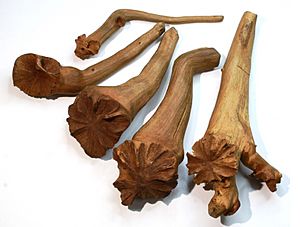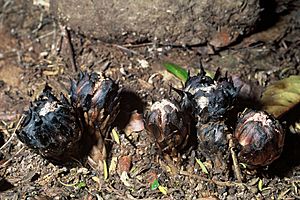Wood rose facts for kids
Quick facts for kids Wood rose |
|
|---|---|
 |
|
| Conservation status | |
 Nationally Vulnerable (NZ TCS) |
|
| Scientific classification | |
| Genus: |
Dactylanthus (plant)
|
| Species: |
taylorii
|
The Dactylanthus taylorii, also called the wood rose, is a very special plant found only in New Zealand. It's a parasitic plant, which means it gets all its food and nutrients from another plant, called a host tree.
When the wood rose grows on a host tree, the tree's roots form a cool, rose-like shape. This is how the plant got its common name! Its flowers grow on the forest floor and are pollinated by native bats.
Contents
What is the Wood Rose?
The wood rose looks like a round, bumpy lump, up to 50 centimeters wide. It doesn't have roots of its own. Instead, it has a special part called a haustorium that connects to the host tree's roots. This part sucks up all the food the wood rose needs.
This plant doesn't have regular leaves that make food from sunlight (photosynthesis). Its leaves are tiny and look more like flower parts. Some wood roses can live for over 30 years!
Wood roses like damp soil but not places that are too wet. You can often find them near small streams. They can grow on about 30 different types of native trees and shrubs. They especially like trees that grow at the edge of older forests. Some common host trees include pate, five-finger, lemonwood, and putaputaweta.
How Wood Roses Reproduce
Plants are either male or female. They flower between February and May. The main animals that help pollinate them are the native short-tailed bats. These bats fly close to the ground and visit the flowers.
Scientists have also found clues that the kakapo, a flightless parrot, might have helped pollinate them long ago. After pollination, the plants make tiny fruits, less than 2 millimeters long. The flowers give off a musky smell, a bit like sweat, which attracts the bats.
Unfortunately, introduced animals like mice and rats also visit the flowers. Mice can help pollinate them, but rats often destroy the plants.
Why is it Called a Wood Rose?

The wood rose gets its name from the way it attaches to its host tree. The host tree's roots grow around the wood rose, forming a cool, wavy disk that looks like a wooden flower.
In the past, people dug up thousands of these wooden "roses" to sell as interesting decorations. But digging them up kills the Dactylanthus plant. Now, it's against the law to collect wood roses from public land. It's very important not to collect this threatened plant.
Where Wood Roses Live
Today, the wood rose is only found in the North Island of New Zealand. However, old pollen found in fossils shows that it used to live in the northern South Island too.
You can find it from Puketi Forest in Northland down to Coromandel Peninsula and as far south as Mt Bruce. It also lives from Mt Taranaki to Te Araroa on the East Coast, and on Little Barrier Island.
It's hard to count how many wood roses there are because they are good at hiding. Scientists think there are probably only a few thousand left. Many places where they grow are only known by people who collect them. In 2020, some wood roses from Pureora Forest were moved to special reserves in Wellington to help protect them.
Protecting the Wood Rose

As of 2012, the wood rose is considered a "Threatened – Nationally Vulnerable" species. This means it's at risk of disappearing. The New Zealand Department of Conservation started a plan in 1995 to help save it.
The wood rose faces many dangers:
- Collecting: People still illegally collect the wooden "roses."
- Animals: Animals like possums, rats, pigs, and deer eat the plants.
- Habitat Loss: The places where they live are being destroyed.
- Pollinator Rarity: There aren't as many bats and other animals that help pollinate them or spread their seeds.
To protect the wood rose, conservationists try to control the animals that eat them, especially possums and kiore (Pacific rats). They also put cages around the plants to protect them. However, these cages can also stop bats from pollinating the flowers. So, sometimes people have to hand-pollinate the flowers inside the cages.
Recently, scientists have had success by planting wood rose seeds in forests where the trees form a closed roof. This gives hope for the future of this unique New Zealand plant.


